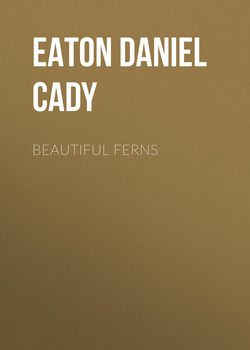Beautiful Ferns

Реклама. ООО «ЛитРес», ИНН: 7719571260.
Оглавление
Eaton Daniel Cady. Beautiful Ferns
ADIANTUM PEDATUM, Linnæus. American Maiden-hair
ONOCLEA STRUTHIOPTERIS, Hoffmann. Ostrich-Fern
PHEGOPTERIS ALPESTRIS, Mettenius. Alpine Beech-Fern
ASPIDIUM FRAGRANS, Swartz. Fragrant Wood-Fern
ASPIDIUM GOLDIANUM, Hooker. Goldie’s Wood-Fern
CHEILANTHES TOMENTOSA, Link. Webby Lip-Fern
CHEILANTHES EATONI, Baker. Eaton’s Lip-Fern
ASPIDIUM FILIX-MAS, Swartz. Male Fern
PELLÆA TERNIFOLIA, Link. Trifoliate Cliff-Brake
PELLÆA ATROPURPUREA, Link. Clayton’s Cliff-Brake
PELLÆA GRACILIS, Hooker. Slender Cliff-Brake
ASPIDIUM MARGINALE, Swartz. Evergreen Wood-Fern
CAMPTOSORUS RHIZOPHYLLUS, Link. Walking-Leaf
ASPLENIUM PINNATIFIDUM, Nuttall. Pinnatifid Spleenwort
ONOCLEA SENSIBILIS, Linnæus. Sensitive Fern
Отрывок из книги
Onoclea Struthiopteris: – Caudex short, thick, erect, emitting slender subterranean stolons; stalks stout, a few inches to a foot long, chaffy at the base; fronds standing in a vase-like crown, dimorphous; sterile ones one to ten feet high, herbaceo-membranaceous, broadly lanceolate, narrowed from the middle to the base, abruptly short-acuminate, pinnate; pinnæ very many, sessile, the lowest ones sinuate and deflexed, the rest three to eight inches long, five to nine lines wide, linear-lanceolate, acuminate, deeply pinnatifid into numerous close-placed oblong obtuse entire segments provided with a midvein and several simple veinlets on each side; fertile fronds in the middle of the crown or vase, much shorter than the sterile, rigid, contracted, narrowed at the base, pinnate; pinnæ one to two inches long, crowded, obliquely ascending, linear, obtuse, sub-entire or pinnately lobed, the lobes one or two lines long and broad, the margins much recurved, and the whole pinna forming a somewhat articulated pod-like body; veinlets of the fertile segments few, soriferous on the back; receptacle elevated; indusium very delicate, lacerate-toothed, half surrounding the sorus; sporangia at length confluent and filling the fertile pinnæ.
Description: – The ostrich-fern is one of our finest ferns, being surpassed in grandeur only by Acrostichum aureum, Woodwardia radicans, and perhaps Osmunda regalis. The plant is propagated chiefly by long and slender stolons, bearing appressed rudimentary stalk-bases. These stolons are said by Sachs to originate from buds formed on the stalks near the base: they run underground for several inches or a foot, and at the end rise to the surface and there thicken into a short erect caudex, covered by imbricating stalk-bases, and throwing up from the apex a grand vase-like circle of foliage, which is often higher than a man’s head, and sometimes extends above his utmost reach.
.....
The sterile fronds are oblong-lanceolate in outline, gradually narrowed to the base from near the middle and abruptly short acuminate. The pinnæ are usually of nearly equal breadth from the base to beyond the middle. They are pinnatifid to within a line of the midrib into numerous oblong and obtuse segments, the veins of which are free, simple and pinnately arranged on a midvein.
The fertile fronds are produced late in the summer, and are contracted, much shorter than the others, and very rigid. The pinnæ are sometimes nearly entire, and in other examples pinnately lobed. The margins are very much recurved, so that the pinnæ are pod-like, and either sub-cylindrical or somewhat moniliform. The venation is free, and the sori are dorsal on the veins. Mr. Faxon writes: “The indusium can be detected only when the fertile frond is very young, and appears as a very delicate, lacerate membrane, attached at the base of the receptacle, and serving to separate the sorus from its neighbors. I have not found it in any case hood-like as in O. sensibilis. The sori are quickly confluent, and all trace of the indusium is soon lost. The membranaceous edge of the transformed fertile pinna is attached near the bases of the inferior sori and a fold is usually found pressed against the sori as seen in the drawing (Fig. 3). This is usually ruptured, so as to leave a portion attached at the base of the sorus, and must not be mistaken for the true indusium, which is within.”
.....